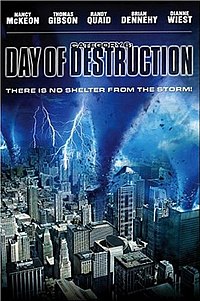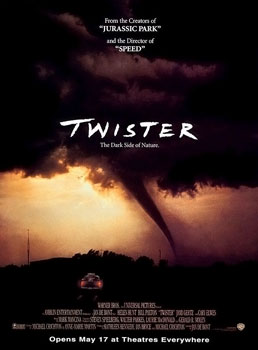
Twister is a 1996 American disaster film directed by Jan de Bont, and written by Michael Crichton and Anne-Marie Martin. It was produced by Crichton, Kathleen Kennedy, and Ian Bryce, with Steven Spielberg, Walter Parkes, Laurie MacDonald, and Gerald R. Molen serving as executive producers. The film stars an ensemble cast that includes Helen Hunt, Bill Paxton, Jami Gertz, and Cary Elwes. It follows a group of storm chasers trying to deploy a tornado research device during a severe outbreak in Oklahoma.

The Day After Tomorrow is a 2004 American science fiction disaster film conceived, co-written, co-produced, and directed by Roland Emmerich, based on the 1999 book The Coming Global Superstorm by Art Bell and Whitley Strieber, and starring Dennis Quaid, Jake Gyllenhaal, Sela Ward, Emmy Rossum, and Ian Holm. The film depicts catastrophic climatic effects following the disruption of the North Atlantic Ocean circulation, in which a series of extreme weather events usher in climate change and lead to a new ice age.

Tetsuya Theodore Fujita was a Japanese and American meteorologist whose research primarily focused on severe weather. His research at the University of Chicago on severe thunderstorms, tornadoes, hurricanes, and typhoons revolutionized the knowledge of each. Although he is best known for creating the Fujita scale of tornado intensity and damage, he also discovered downbursts and microbursts and was an instrumental figure in advancing modern understanding of many severe weather phenomena and how they affect people and communities, especially through his work exploring the relationship between wind speed and damage.

Earthquake is a 1974 American ensemble disaster drama film directed and produced by Mark Robson and starring Charlton Heston and Ava Gardner. The plot concerns the struggle for survival after a catastrophic earthquake destroys most of Los Angeles.
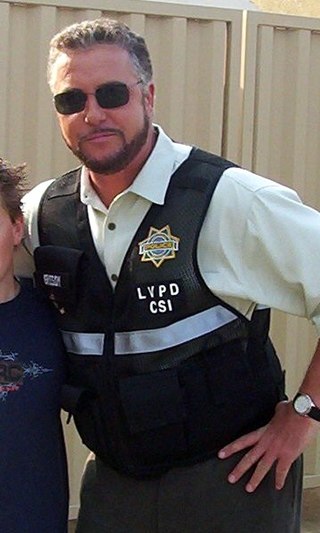
William Louis Petersen is an American actor. He is best known for his role as Gil Grissom in the CBS drama thriller series CSI: Crime Scene Investigation (2000–2015), for which he won a Screen Actors Guild Award and was nominated for a Golden Globe Award; he was further nominated for three Primetime Emmy Awards as a producer of the show. He reprised his role as Gil Grissom in the sequel CSI: Vegas, which premiered on October 6, 2021.

Hurricane Charley was the first of four separate hurricanes to impact or strike Florida during 2004, along with Frances, Ivan and Jeanne, as well as one of the strongest hurricanes ever to strike the United States. It was the third named storm, the second hurricane, and the second major hurricane of the 2004 Atlantic hurricane season. Charley lasted from August 9 to 15, and at its peak intensity it attained 150 mph (240 km/h) winds, making it a strong Category 4 hurricane on the Saffir–Simpson scale. It made landfall in Southwest Florida at maximum strength, making it the strongest hurricane to hit the United States since Hurricane Andrew struck Florida in 1992 and tied with Hurricane Ian as the strongest hurricane to hit southwest Florida in recorded history.
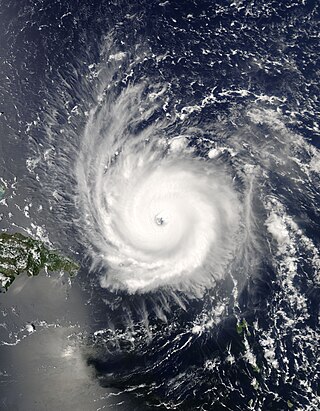
Hurricane Frances was the second most intense tropical cyclone in the Atlantic during 2004 and proved to be very destructive in Florida. It was the sixth named storm, the fourth hurricane, and the third major hurricane of the 2004 Atlantic hurricane season. The system crossed the open Atlantic in late August, moving to the north of the Lesser Antilles while strengthening. Its outer bands struck Puerto Rico and the British Virgin Islands while passing north of the Caribbean Sea. The storm's maximum sustained winds peaked at 145 mph (233 km/h), achieving Category 4 on the Saffir-Simpson Hurricane Scale. As the system's forward motion slowed, the eye passed over San Salvador Island and very close to Cat Island in the Bahamas. Frances was the first hurricane to impact the entire Bahamian archipelago since 1928 and almost completely destroyed their agricultural economy.
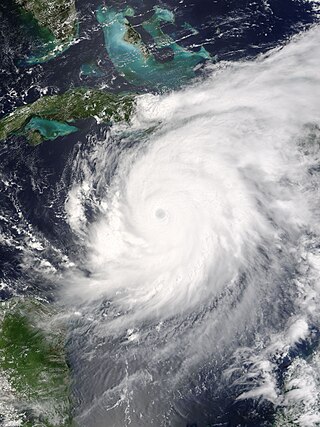
Hurricane Ivan was a large, long-lived, and devastating tropical cyclone that caused widespread damage in the Caribbean and United States. The ninth named storm, the sixth hurricane, and the fourth major hurricane of the active 2004 Atlantic hurricane season, Ivan formed in early September and reached Category 5 strength on the Saffir–Simpson Hurricane Scale (SSHS). Ivan caused catastrophic damage in Grenada as a strong Category 3 storm, heavy damage in Jamaica as a strong Category 4 storm, and then severe damage in Grand Cayman, Cayman Islands, and the western tip of Cuba as a Category 5 hurricane. After peaking in strength, the hurricane moved north-northwest across the Gulf of Mexico to strike Pensacola/Milton, Florida and Alabama as a strong Category 3 storm, causing significant damage. Ivan dropped heavy rain on the Southeastern United States as it progressed northeastward and eastward through the Eastern United States, becoming an extratropical cyclone on September 18. The remnant low of the storm moved into the western subtropical Atlantic and regenerated into a tropical cyclone on September 22, which then moved across Florida and the Gulf of Mexico, and then into Louisiana and Texas, causing minimal damage. Ivan degenerated into a remnant low on September 24, before dissipating on the next day.

Aftershock: Earthquake in New York is a 1999 miniseries that was broadcast in the United States on CBS in two parts, with the first part aired on November 14 and the second on November 16. It was released to VHS in 2000, and on DVD in 2001. It is based on a book written by Chuck Scarborough. Starring Charles S. Dutton, Sharon Lawrence, Tom Skerritt, Lisa Nicole Carson, Jennifer Garner, Rachel Ticotin and Frederick Weller. under the direction of Mikael Salomon, the miniseries follows five groups of people in the aftermath of a large earthquake destroying New York City.
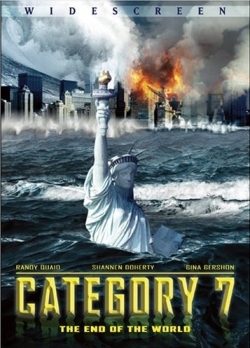
Category 7: The End of the World is a 2005 three-hour American made-for-television disaster miniseries and B movie that was broadcast in the United States on CBS in two parts, the first part aired on November 6 and the second on November 13. It was directed by Dick Lowry. A sequel to the 2004 miniseries Category 6: Day of Destruction, this film starts directly after the events shown in that film. The new director of the Federal Emergency Management Agency (FEMA) must continue to contend with the massive storm system that hit Chicago in the first film. The storm has continued to gain strength, spawning additional storms around the world, with three converging over Washington, D.C., and forming a massive category 7 hurricane.

It Could Happen Tomorrow is a television series that premiered on January 15, 2006 on The Weather Channel. It explored the possibilities of various weather and other natural phenomena severely damaging or destroying America's cities. This included: a Category 3 hurricane hitting New York City, an F4 tornado destroying Washington, D.C., dormant volcano Mount Rainier re-activating and destroying towns in the surrounding valleys, a tsunami flooding the Pacific Northwest coast, an intraplate earthquake impacting Memphis, Tennessee, wildfires spreading into the heart of San Diego, a huge earthquake leveling San Francisco, a flash flood in Boulder, Colorado, and a flood in Sacramento. More recent episodes included an earthquake in Las Vegas, an F5 tornado ripping its way through Chicago and Dallas, and more.

"Tempest" is the twenty-first episode and season finale of the first season of the WB original series Smallville. The episode originally aired on May 21, 2002; Alfred Gough and Miles Millar wrote the script, and Greg Beeman directed. In the episode's narrative, Lex attempts to forge his own destiny away from LuthorCorp; Whitney leaves Smallville for the Marines; Roger Nixon discovers Clark's secret and attempts to expose him to the world; and Lana is pulled into a tornado.
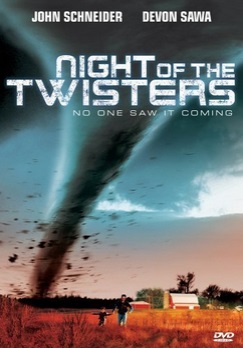
Night of the Twisters is a 1996 made-for-television disaster film that was directed by Timothy Bond. The film premiered on The Family Channel on February 11, 1996, as the cable channel's first original movie.

Storm Chasers is an American documentary reality television series that premiered on October 17, 2007, on the Discovery Channel. Produced by Original Media, the program follows several teams of storm chasers as they attempt to intercept tornadoes in Tornado Alley in the United States. The show was canceled at the end of its 5th season by Discovery Communications on January 21, 2012.

The Great Los Angeles Earthquake is a 1990 American made-for-television disaster film about a massive earthquake that strikes Los Angeles, California. The movie stars Joanna Kerns in the movie's lead role, seismologist Clare Winslow, who tries to warn city leaders of the possibility that a powerful earthquake may strike southern California. The film aired on NBC on November 11–12, 1990.
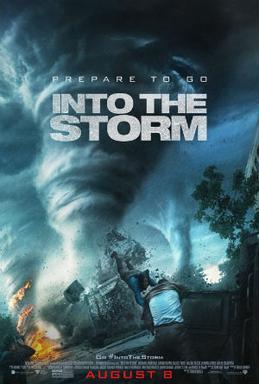
Into the Storm is a 2014 American found footage disaster film directed by Steven Quale, written by John Swetnam, and starring Richard Armitage, Sarah Wayne Callies, Matt Walsh, Alycia Debnam-Carey, and Arlen Escarpeta. It is a meteorological disaster film about a rash of tornadoes striking the fictional town of Silverton, Oklahoma.
"The Erinsborough Tornado" is a storyline from the Australian television soap opera Neighbours, which began on 29 August 2014 when a large storm hit the fictional suburb of Erinsborough and later developed into a tornado. The storyline was one of the dramatic events of Neighbours in 2014 and saw many characters' fates left in question, including long standing characters Paul Robinson and Lou Carpenter. The storyline was conceived following the success of 2013's wedding explosion and was shot in June 2014. Several wind and rain machines were used to create the storm and tornado effects. A promotional trailer for the storyline was released on 15 August 2014.

An intense derecho affected much of the Midwestern United States on August 10–11, 2020, primarily eastern Nebraska, Iowa, Illinois, Wisconsin, and Indiana. It caused high winds and spawned an outbreak of weak tornadoes. Some areas reported torrential rain and large hail.
